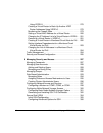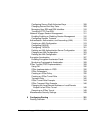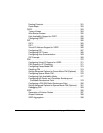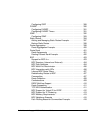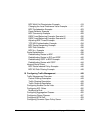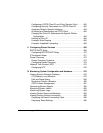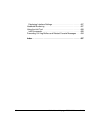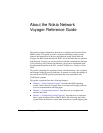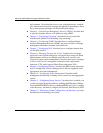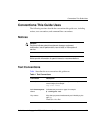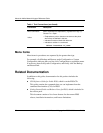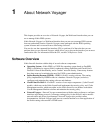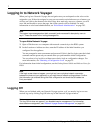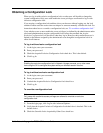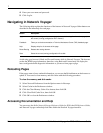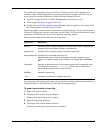
About the Nokia Network Voyager Reference Guide
20 Nokia Network Voyager for IPSO 4.0 Reference Guide
the hostname . It also describes how to save configuration sets, schedule
jobs, backup and restore files, manage and upgrade system images, reboot
the system, manage packages, and advanced system tuning.
Chapter 4, “Virtual Router Redundancy Protocol (VRRP)” describes how
to provides dynamic failover of IP addresses using VRRP.
Chapter 5, “Configuring Clustering” describes how to provide fault
tolerance and dynamic load balancing using clustering.
Chapter 6, “Configuring SNMP” describes how to configure Simple
Network Management Protocol (SNMP), the protocol used to exchange
management information between network devices.
Chapter 7, “Configuring IPv6” describes how to configure features that
use the IPv6 protocol.
Chapter 8, “Managing Security and Access” desribes how to manage
passwords, user accounts and groups, assign privileges using role-based
administration, and how to configure network access, services, and
Network Voyager session management. It also describes how to configure
AAA for a new service, encryption acceleration, and virtual tunnel
interfaces (VTI), which support Check Point route-based VPN..
Chapter 9, “Configuring Routing” describes the IPSO routing subsystem,
how to configure the various routing protocols that are supported, route
aggregation, and route redistribution.
Chapter 10, “Configuring Traffic Management” describes traffic
management functionality, including access control lists and aggregation
classes.
Chapter 11, “Configuring Router Services” describes how to enable your
system to forward broadcast traffic by enabling the IP Broadcast Helper,
forward BOOTP/DHCP traffic by enabling BOOTP relay, how to enable
router discovery, and how to configure for Network Time Protocol (NTP).
Chapter 12, “Monitoring System Configuration and Hardware” provides
information on monitoring your system.



